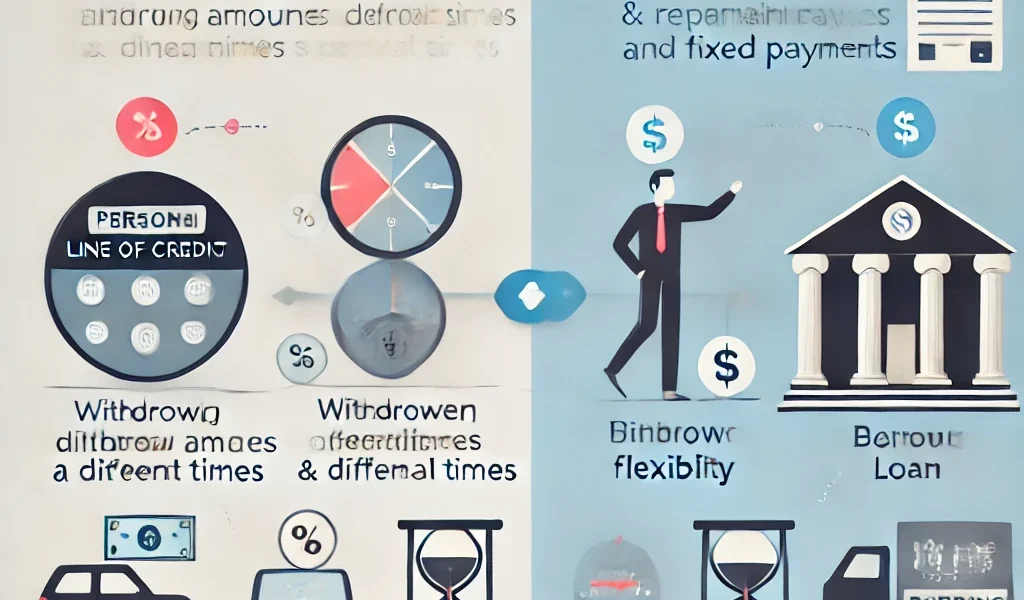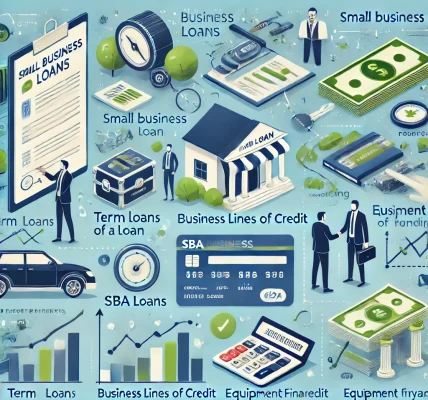Introduction
When borrowing money, individuals have several options, including a personal line of credit and a traditional loan. While both options provide financial assistance, they work differently in terms of repayment, flexibility, and cost.
Understanding these differences is crucial for making informed borrowing decisions. In this guide, we will explore how a personal line of credit differs from a traditional loan, their benefits, drawbacks, and when to choose each option.
What is a Personal Line of Credit?
A personal line of credit (PLOC) is a revolving credit account that allows borrowers to withdraw funds up to a set credit limit. Unlike a traditional loan, where you receive a lump sum upfront, a personal line of credit enables you to withdraw funds as needed and only pay interest on the amount used.
How It Works
- The lender approves a credit limit based on creditworthiness.
- The borrower can withdraw any amount (up to the limit) as needed.
- Interest is charged only on the withdrawn amount.
- The borrower can repay and re-borrow funds within the draw period.
Example
Suppose you are approved for a $10,000 personal line of credit. You withdraw $3,000, so you only pay interest on that amount. If you repay it, you can withdraw funds again without reapplying.
What is a Traditional Loan?
A traditional loan is a fixed borrowing amount provided by a lender, which must be repaid in equal monthly installments over a set term. Interest is charged on the entire loan amount from the start.
How It Works
- The borrower applies for a fixed amount.
- The lender disburses the full loan amount upfront.
- The borrower repays in fixed monthly installments over a set term.
- Interest is applied to the total loan amount from the beginning.
Example
Suppose you take a $10,000 personal loan with a 5-year repayment term at 8% interest. You will repay a fixed monthly installment, regardless of whether you use the full amount immediately.
Key Differences Between a Personal Line of Credit and a Traditional Loan
| Feature | Personal Line of Credit | Traditional Loan |
|---|---|---|
| Loan Disbursement | Withdraw as needed | Lump sum upfront |
| Interest Charges | Only on withdrawn amount | On the full amount |
| Repayment Flexibility | Flexible payments | Fixed monthly payments |
| Reusability | Yes, funds can be reused | No, must apply for a new loan |
| Best For | Ongoing, unpredictable expenses | One-time, fixed costs |
| Example | Home renovation, medical expenses | Car purchase, debt consolidation |
Pros and Cons of a Personal Line of Credit
Pros:
✔ Flexible Access to Funds – Borrow only what you need.
✔ Interest Savings – Pay interest only on the used amount.
✔ Reusable Credit – Once repaid, funds can be accessed again.
✔ Good for Emergency Expenses – Ideal for uncertain financial needs.
Cons:
✖ Variable Interest Rates – Rates can fluctuate over time.
✖ Requires Good Credit – Approval depends on a strong credit history.
✖ Discipline Required – Easy access to funds may lead to overspending.
Pros and Cons of a Traditional Loan
Pros:
✔ Fixed Payments – Predictable repayment schedule.
✔ Lower Interest Rates – Often lower than credit lines.
✔ Best for Large Expenses – Ideal for home purchases, vehicles, or major debt consolidation.
Cons:
✖ Interest on Full Amount – You pay interest even on unused funds.
✖ Less Flexibility – You cannot re-borrow once repaid.
✖ Longer Application Process – Approval may take longer.
When to Choose a Personal Line of Credit vs. a Traditional Loan?
| Situation | Best Option |
|---|---|
| Need funds for ongoing expenses | Personal Line of Credit |
| Need a lump sum for a one-time purchase | Traditional Loan |
| Want flexible borrowing & repayments | Personal Line of Credit |
| Prefer fixed payments and lower rates | Traditional Loan |
| Have unpredictable expenses | Personal Line of Credit |
| Funding home renovation over time | Personal Line of Credit |
| Buying a car | Traditional Loan |
Conclusion
Both a personal line of credit and a traditional loan have their advantages. A PLOC offers flexibility and is ideal for ongoing or unpredictable expenses, while a traditional loan is best for large, one-time purchases with a fixed repayment schedule.
Before deciding, consider your financial needs, repayment ability, and interest costs. Compare lenders and ensure you choose the best borrowing option for your financial situation.




